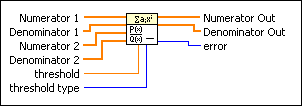 |
Numerator 1 contains the numerator polynomial coefficients, in ascending order of power, of the first rational polynomial G1.
|
 |
Denominator 1 contains the denominator polynomial coefficients, in ascending order of power, of the first rational polynomial G1.
|
 |
Numerator 2 contains the numerator polynomial coefficients, in ascending order of power, of the second rational polynomial G2.
|
 |
Denominator 2 contains the denominator polynomial coefficients, in ascending order of power, of the second rational polynomial G2.
|
 |
threshold specifies the level at which the VI removes from Numerator Out or Denominator Out the trailing elements whose absolute values or relative values are less than or equal to threshold. If all the elements in Numerator Out or Denominator Out are less than or equal to threshold, Numerator Out or Denominator Out returns a one-element array.
|
 |
threshold type specifies how the VI removes the trailing elements from Numerator Out or Denominator Out. If threshold type is Absolute Value, the VI removes the trailing elements from Numerator Out or Denominator Out whose absolute values are less than or equal to threshold. If threshold type is Relative Value, the VI removes the trailing elements from Numerator Out or Denominator Out whose absolute values are less than or equal to threshold * |x|, where x is the coefficient which has the maximum absolute value in resulting numerator or denominator polynomial.
| 0 | Absolute Value (default) | | 1 | Relative Value |
|
 |
Numerator Out returns the numerator polynomial coefficients, in ascending order of power, of the rational polynomial that results from the mathematical operation.
|
 |
Denominator Out returns the denominator polynomial coefficients, in ascending order of power, of the rational polynomial that results from the mathematical operation.
|
 |
error returns any error or warning from the VI. You can wire error to the Error Cluster From Error Code VI to convert the error code or warning into an error cluster.
|
 |
Numerator 1 contains the numerator polynomial coefficients, in ascending order of power, of the first rational polynomial G1.
|
 |
Denominator 1 contains the denominator polynomial coefficients, in ascending order of power, of the first rational polynomial G1.
|
 |
Numerator 2 contains the numerator polynomial coefficients, in ascending order of power, of the second rational polynomial G2.
|
 |
Denominator 2 contains the denominator polynomial coefficients, in ascending order of power, of the second rational polynomial G2.
|
 |
threshold specifies the level at which the VI removes from Numerator Out or Denominator Out the trailing elements whose absolute values or relative values are less than or equal to threshold. If all the elements in Numerator Out or Denominator Out are less than or equal to threshold, Numerator Out or Denominator Out returns a one-element array.
|
 |
threshold type specifies how the VI removes the trailing elements from Numerator Out or Denominator Out. If threshold type is Absolute Value, the VI removes the trailing elements from Numerator Out or Denominator Out whose absolute values are less than or equal to threshold. If threshold type is Relative Value, the VI removes the trailing elements from Numerator Out or Denominator Out whose absolute values are less than or equal to threshold * |x|, where x is the coefficient which has the maximum absolute value in resulting numerator or denominator polynomial.
| 0 | Absolute Value (default) | | 1 | Relative Value |
|
 |
Numerator Out returns the numerator polynomial coefficients, in ascending order of power, of the rational polynomial that results from the mathematical operation.
|
 |
Denominator Out returns the denominator polynomial coefficients, in ascending order of power, of the rational polynomial that results from the mathematical operation.
|
 |
error returns any error or warning from the VI. You can wire error to the Error Cluster From Error Code VI to convert the error code or warning into an error cluster.
|
 Add to the block diagram
Add to the block diagram Find on the palette
Find on the palette







